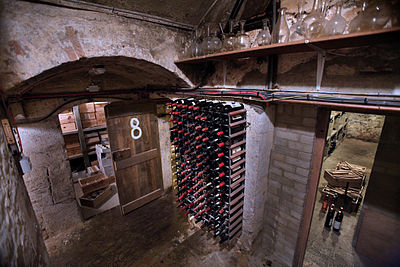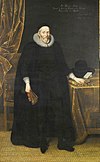| Main page | Indices | Projects |
The University of Oxford portal
The University of Oxford is a collegiate research university in Oxford, England. There is evidence of teaching as early as 1096, making it the oldest university in the English-speaking world and the world's second-oldest university in continuous operation. It grew rapidly from 1167, when Henry II banned English students from attending the University of Paris. After disputes between students and Oxford townsfolk in 1209, some academics fled north-east to Cambridge where they established what became the University of Cambridge. The two English ancient universities share many common features and are jointly referred to as Oxbridge.
The University of Oxford is made up of thirty-nine semi-autonomous constituent colleges, four permanent private halls, and a range of academic departments which are organised into four divisions. Each college is a self-governing institution within the university, controlling its own membership and having its own internal structure and activities. All students are members of a college. Traditionally, each of Oxford's constituent colleges is associated with another of the colleges in the University of Cambridge, with the only exceptional addition of Trinity College, Dublin. It does not have a main campus, and its buildings and facilities are scattered throughout the city centre. Undergraduate teaching at Oxford consists of lectures, small-group tutorials at the colleges and halls, seminars, laboratory work and occasionally further tutorials provided by the central university faculties and departments. Postgraduate teaching is provided in a predominantly centralised fashion.
Oxford operates the Ashmolean Museum, the world's oldest university museum; Oxford University Press, the largest university press in the world; and the largest academic library system nationwide. In the fiscal year ending 31 July 2023, the university had a total consolidated income of £2.92 billion, of which £789 million was from research grants and contracts.
Oxford has educated a wide range of notable alumni, including 30 prime ministers of the United Kingdom and many heads of state and government around the world. 73 Nobel Prize laureates, 4 Fields Medalists, and 6 Turing Award winners have matriculated, worked, or held visiting fellowships at the University of Oxford, while its alumni have won 160 Olympic medals. Oxford is the home of numerous scholarships, including the Rhodes Scholarship, one of the oldest international graduate scholarship programmes. ( Full article...)
Selected article
The university's position of Savilian Professor of Geometry was established in 1619. It was founded (at the same time as the Savilian Professorship of Astronomy) by Sir Henry Savile (pictured), a mathematician who was Warden of Merton College, reacting to what has been described as "the wretched state of mathematical studies in England" at that time. He appointed Henry Briggs as the first professor. There have been 19 geometry professors in all, with the most recent, Nigel Hitchin, appointed to the chair in 1997. Past professors include Edmond Halley, the astronomer, and Baden Powell, the father of the founder of the scout movement Robert Baden-Powell. Edward Titchmarsh (professor from 1931 to 1963) said when applying that he was not prepared to lecture on geometry, and the requirement was removed from the duties of the post to enable his appointment, although the title of the chair was not changed. The two Savilian chairs have been linked with professorial fellowships at New College since the late 19th century. Before then, for over 175 years until the middle of the 19th century, the geometry professors had an official residence adjoining the college in New College Lane. ( Full article...)
Selected biography
Selected college or hall
Selected image

Did you know
Articles from Wikipedia's " Did You Know" archives about the university and people associated with it:
- ... that the members of the Council of Keble College, Oxford (council member Henry Herbert, 4th Earl of Carnarvon pictured) had power to move the college away from Oxford?
- ... that British lawyer and activist of the Indian independence movement Eardley Norton was instrumental in establishing an UK-chapter of the Indian National Congress?
- ... that in 1996, the University of Glasgow renamed its Chair of Drama after former professor James Fullarton Arnott?
- ... that while Nicholas Fitzherbert was abroad, two priests were arrested in his father's house and hanged, drawn and quartered?
- ... that the equipment designed by the physicist Gwyn Jones to liquefy small amounts of helium for work at temperatures near absolute zero was made from parts of a motorcycle engine?
Selected quotation
Selected panorama
Wikimedia
The following Wikimedia Foundation sister projects provide more on this subject:
-
Commons
Free media repository -
Wikibooks
Free textbooks and manuals -
Wikidata
Free knowledge base -
Wikinews
Free-content news -
Wikiquote
Collection of quotations -
Wikisource
Free-content library -
Wikiversity
Free learning tools -
Wikivoyage
Free travel guide -
Wiktionary
Dictionary and thesaurus
| Main page | Indices | Projects |
The University of Oxford portal
The University of Oxford is a collegiate research university in Oxford, England. There is evidence of teaching as early as 1096, making it the oldest university in the English-speaking world and the world's second-oldest university in continuous operation. It grew rapidly from 1167, when Henry II banned English students from attending the University of Paris. After disputes between students and Oxford townsfolk in 1209, some academics fled north-east to Cambridge where they established what became the University of Cambridge. The two English ancient universities share many common features and are jointly referred to as Oxbridge.
The University of Oxford is made up of thirty-nine semi-autonomous constituent colleges, four permanent private halls, and a range of academic departments which are organised into four divisions. Each college is a self-governing institution within the university, controlling its own membership and having its own internal structure and activities. All students are members of a college. Traditionally, each of Oxford's constituent colleges is associated with another of the colleges in the University of Cambridge, with the only exceptional addition of Trinity College, Dublin. It does not have a main campus, and its buildings and facilities are scattered throughout the city centre. Undergraduate teaching at Oxford consists of lectures, small-group tutorials at the colleges and halls, seminars, laboratory work and occasionally further tutorials provided by the central university faculties and departments. Postgraduate teaching is provided in a predominantly centralised fashion.
Oxford operates the Ashmolean Museum, the world's oldest university museum; Oxford University Press, the largest university press in the world; and the largest academic library system nationwide. In the fiscal year ending 31 July 2023, the university had a total consolidated income of £2.92 billion, of which £789 million was from research grants and contracts.
Oxford has educated a wide range of notable alumni, including 30 prime ministers of the United Kingdom and many heads of state and government around the world. 73 Nobel Prize laureates, 4 Fields Medalists, and 6 Turing Award winners have matriculated, worked, or held visiting fellowships at the University of Oxford, while its alumni have won 160 Olympic medals. Oxford is the home of numerous scholarships, including the Rhodes Scholarship, one of the oldest international graduate scholarship programmes. ( Full article...)
Selected article
The university's position of Savilian Professor of Geometry was established in 1619. It was founded (at the same time as the Savilian Professorship of Astronomy) by Sir Henry Savile (pictured), a mathematician who was Warden of Merton College, reacting to what has been described as "the wretched state of mathematical studies in England" at that time. He appointed Henry Briggs as the first professor. There have been 19 geometry professors in all, with the most recent, Nigel Hitchin, appointed to the chair in 1997. Past professors include Edmond Halley, the astronomer, and Baden Powell, the father of the founder of the scout movement Robert Baden-Powell. Edward Titchmarsh (professor from 1931 to 1963) said when applying that he was not prepared to lecture on geometry, and the requirement was removed from the duties of the post to enable his appointment, although the title of the chair was not changed. The two Savilian chairs have been linked with professorial fellowships at New College since the late 19th century. Before then, for over 175 years until the middle of the 19th century, the geometry professors had an official residence adjoining the college in New College Lane. ( Full article...)
Selected biography
Selected college or hall
Selected image

Did you know
Articles from Wikipedia's " Did You Know" archives about the university and people associated with it:
- ... that the members of the Council of Keble College, Oxford (council member Henry Herbert, 4th Earl of Carnarvon pictured) had power to move the college away from Oxford?
- ... that British lawyer and activist of the Indian independence movement Eardley Norton was instrumental in establishing an UK-chapter of the Indian National Congress?
- ... that in 1996, the University of Glasgow renamed its Chair of Drama after former professor James Fullarton Arnott?
- ... that while Nicholas Fitzherbert was abroad, two priests were arrested in his father's house and hanged, drawn and quartered?
- ... that the equipment designed by the physicist Gwyn Jones to liquefy small amounts of helium for work at temperatures near absolute zero was made from parts of a motorcycle engine?
Selected quotation
Selected panorama
Wikimedia
The following Wikimedia Foundation sister projects provide more on this subject:
-
Commons
Free media repository -
Wikibooks
Free textbooks and manuals -
Wikidata
Free knowledge base -
Wikinews
Free-content news -
Wikiquote
Collection of quotations -
Wikisource
Free-content library -
Wikiversity
Free learning tools -
Wikivoyage
Free travel guide -
Wiktionary
Dictionary and thesaurus














